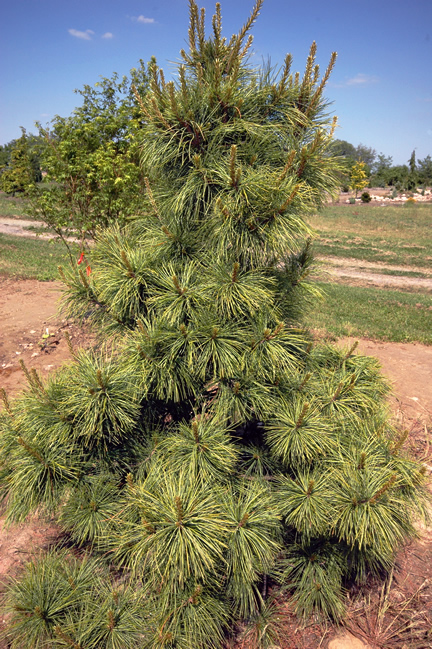| General Description | A rare, slow growing, attractive blue-green evergreen tree. |
| ID Characteristic | Leaves are blue-green, long, soft, serrated and in fascicles of fives. Trunk is often forked, grey-brown with exfoliating bark. Twigs are red brown and pubescent. Buds are red-brown and resinous. Loosely pyramidal form, branching to the ground. Upper branches are ascending. Cones have recurved scales and contain large wingless seeds. Root system is minimal. |
| Shape | Broad and irregularly pyramidal, becoming more rounded with age. |
| Landscape | An excellent specimen tree especially for the oriental garden. Appropriate for small landscapes due to slow growth. Can also be used in groupings or screens. |
| Propagation | Seeds do not require any pre-treatment, although stratifying at less than 4 °C for 6 weeks will speed up the germination process. Cuttings can be successful if taken from trees less than 10 years old. Cultivars are grafted. |
| Cultivation | Very adaptable and hardy. Best suited to a well drained soil preferably sand, gravel or sandy loam. Requires full sun. Drought tolerant once roots establish. |
| Pests | Pests are rare due to the isolation of the species. |
| Notable Specimens | UWO Plant Sciences Station, Ilderton, Ontario. Whistling Gardens Ltd, Wilsonville, Ontario. |
| Habitat | Adaptable but prefers well drained soils and full sun. Mountain Slopes and river valleys. |
| Bark/Stem Description | Twigs are smooth, pubescent, red-brown or sometimes yellow. Aged bark is grey-brown with thin exfoliating scales. Inner layer is red-brown. |
| Flower/Leaf Bud Description | Acute with long narrow scales. 10-18 mm long, red-brown. Ranging from light to heavily resinous. |
| Leaf Description | Needles in fascicles of fives, sometimes threes with serrated margins. Three sided, glossy dark green on top, blue or white-blue on two of the undersides. 9-13 cm long, 1-1.2 mm wide. Appearing stiff but are actually soft. Loosely arranged. |
| Flower Description | Monoecious, inflorescence 1-3 cm long. Males are yellow turning deep red, females are red. Located on young shoots in clusters. Wind pollinated, not self-fertile. |
| Fruit Description | Pollen cones are 15-20 mm long and red. Seed cones 9-14 cm long, green-purple when young, turning reddish brown or yellow-brown. Scales are diamond shaped and curved back at the ends and sometimes prickled. Indehiscent, with seed 2.5 cm long. |
| Colour Description | Needles give the tree an overall bluish green hue. Bark ranges from red-brown to grey-brown with reddish undertones. Cones are a red-brown, sometimes yellow-brown. |
| Texture Description | Medium in all seasons. |
